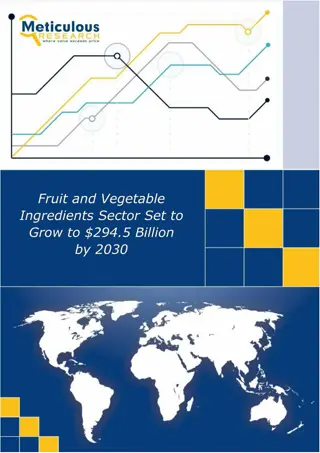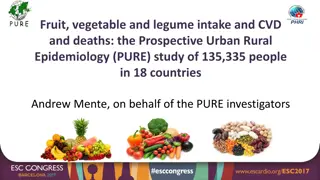Fresh Fruit and Vegetable Program Update Training Session
Fresh Fruit and Vegetable Program Update Training Session took place on November 16, 2018, focusing on program goals, objectives, school eligibility, funding allocation, and usage in Hawaii. The program aims to create a healthier school environment, increase students' produce consumption, and integrate nutrition education. Schools serving K-6th grade students, operating NSLP, and committed to program objectives are eligible. Schools receive funds based on student enrollment, must submit correct monthly claims, and manage administrative costs. Hawaii's FFVP funds usage in previous years indicated unutilized funds returned to USDA, but recently program usage increased.
Download Presentation

Please find below an Image/Link to download the presentation.
The content on the website is provided AS IS for your information and personal use only. It may not be sold, licensed, or shared on other websites without obtaining consent from the author.If you encounter any issues during the download, it is possible that the publisher has removed the file from their server.
You are allowed to download the files provided on this website for personal or commercial use, subject to the condition that they are used lawfully. All files are the property of their respective owners.
The content on the website is provided AS IS for your information and personal use only. It may not be sold, licensed, or shared on other websites without obtaining consent from the author.
E N D
Presentation Transcript
Fresh Fruit and Vegetable Program November 16, 2018 Fiscal Year Update Training Session Al Tachibana, Program Specialist Fresh Fruit and Vegetable Program & NSLP Equipment Assistant Grants
FFVP GOALS Create a healthier school environment by providing healthy food choices. Expand the variety of produce students consume. Increase students produce consumption. Make a difference in students diets to impact their present and future health.
Program Objectives Build a strong school-level FFVP team Tie FFVP into school s Wellness Plan Develop effective program Action-Implementation Plan Integrate FFVP into core curriculum Create healthier school community Develop nutrition education Manage budget & claim procedures
School Eligibility Must be a school serving K - 6th grade Pre-School students can count toward school s allocation if part of school s enrollment Must operate NSLP Submit a yearly application Must be committed to fulfilling program objectives Priority schools have 50% or more of students eligible for Free or Reduced price meals But, schools under 50% Free/Red. can be accepted in FFVP if sufficient funds remain after schools with higher priority are accommodated
Approved Schools Receive funds based on an allocation of $50 - $75 per student using enrollment figures of previous year DOE Oct. data for grade K-6 Must submit a correct monthly claim on time and stay within budget Up to 10% Administrative Costs for planning, paperwork, nutrition education planning; not prep/service Equipment costs for FFVP comes out of the Admin. Costs Up to 20% for program operating costs to include salary and fringe benefits for employee cost to wash, prep, distribute and serve food
FFVP Usage in Hawaii Any unused funding goes back to the USDA at the end of the year SY16-17 FFVP Total Funds Used Compared to Allocated $2,130,884 $2,200,000.00 Usually, just 80% of Hawaii s FFVP funds gets used Graph shows July 2016-June 2017 claims $1,700,000.00 That meant after SY15-16, over $400,000 of unused Fresh Fruit & Vegetable funds went back to USDA. $1,257,187 $1,200,000.00 At the end of SY16-17, only 59% of the available FFVP funds were used which meant almost $900,00 of FFVP funds were unused. $700,000.00 For FY 2017-18, the SFSB allocation is $1,728,194. $200,000.00 Allocated Used The Favorable News is that according to most recent figures* FFVP usage for FY17-18 went up to 89%*! -$300,000.00 *Figures not yet verified by HCNP Fiscal
FFVP FISCAL YEAR TIMELINE FFVP FISCAL YEAR TIMELINE Allocations End for Non-Continuing Schools Allocations Begin For NEW Schools NEW FY ALLOCATION STARTS FFVP ENDS AT MOST SCHOOLS 2018 2019 AUG SEP AUG OCT NOV FEB JUN DEC JUL APR MAY MAR JAN SEP FY BEGINS OCT 1 FY ENDS SEP 30 OCTOBER - MAY SY 2018-19 SY 2019-20 AUGUST SEP 30
CLAIM ERRORS FROM NEW FISCAL ALLOCATION IN HCNP_S There were Separate Allocations for Aug-Sep Claim Period Final time a separate allocation will be done New FFVP Claim Workbooks are based on Fiscal Year SFAs made Claims of $X for Operation and $Y for Admin. Costs.
FFVP Produce Procurement Procurement is an area now subject to Administrative Review 1. Micro purchasing (for 2018 , transactions of $10,000 or less) To the extent practicable, purchases must be distributed equitably among qualified suppliers. Price comparisons are not required, but the price(s) should be considered reasonable. 2. Solicitation Getting bids to select a single vendor Contact HCNP for procurement advisement and assistance
Sample of Form10-B for FFVP
Handbook Highlights FFVP encourages (pg. 8) Schools to make every effort to provide fresh fruits and vegetables a minimum of twice a week as repeated exposure to new foods is a key to acceptance A variety of implementation strategies Complementary nutrition education Schools should develop guidelines to remind children of good manners when they receive and eat their fruit and vegetable snacks, and to dispose their trash (pg. 13)
Handbook Highlights FFVP does not allow (pg. 14) Processed or preserved fruits and veggies (canned, frozen, or dried) Dip for fruit Fruit Strips, Leather, Jellied Fruit, Trail Mix Fruit or Vegetable juice, or FV Pizza Smoothies Only teachers who are directly responsible for serving FV to their students in a classroom setting may partake in FV (pg. 10) Free FV cannot be used as gifts or rewards. FV cannot be withhold as a form of discipline (pg. 10)
Handbook Highlights Limitations (pg. 15) Dips for veggies Must be yogurt-based, or low-fat/non-fat dips Serving size limited to 1-2 tablespoons Service of prepared vegetables Fresh vegetables that are steamed or baked such as sweet potato and kalo, or stir fried, must be limited to once-a-week and always as part of a nutrition education lesson related to the prepared item
Handbook Highlights Leftovers (pg. 18) Plan to reduce waste (order as accurately as possible) Follow safe food storage practices If still good, use leftover FV in next FFVP snack Leftover FV should not be going home with staff or teachers
Program Implementation (strongly suggested for successful program) Program should begin within 30 days of the start of the school year Snack days are consistent and integrated in weekly schedule FFVP is integrated into core curriculum Plan ahead create a full years calendar with seasonal produce Establish relationship with vendors Involve faculty and staff, PCNC, parents and Wellness Team
Best times and Places to Serve Do serve during the school day as snack Do not serve during breakfast, lunch, after school or summer school. Do serve inside classrooms, hallways, kiosks Integrate within a core subject and as part of a nutrition education activity
Marketing and Promotion No funds available for promotional activities Lots of resources on the internet Invite community partners and local resources to assist Engage the entire school community and integrate FFVP into all of your school programs and special events
Nutrition Education Make nutrition education a priority in Wellness Policy and school s Academic and Financial Plan Integrate nutrition education into core subjects: language arts, math, art, science Consider planting a school garden
School Environment Create FFVP bulletin board, posters Create a snack, celebration, fundraising policy consistent with Wellness Guidelines Invite local chefs to participate in food demonstrations Use vendors as resources Have parent-child cooking classes Develop a year-round theme: -- Ex: Eat a Rainbow theme Each week a different color Seasons/Holidays/Cultures Each month
Create a Healthier School FFVP guidelines support efforts of school s Wellness Policy Get Local Support To access local resources, banners, brochures, flyers, posters, speakers, training and funding opportunities, register to become a Hawaii 5210 school at http://www.hawaii5210.com
Mahalo! Contact Information Al Tachibana Fresh Fruit & Vegetable Program 650 Iwilei Road, Suite 270 Honolulu, HI 96817 Alvin_Tachibana@notes.k12.hi.us Office: 808-587-3600























